FNSrsk602 - Risk Management Strategy Development: Westpac Bank
VerifiedAdded on 2023/04/20
|16
|3773
|434
Report
AI Summary
This report presents a comprehensive risk management strategy tailored for the Westpac Bank Group. It begins with an analysis of key risk factors, including financial and technical resources, emphasizing the importance of consequence and probability assessment, risk impact evaluation, and prioritization. The strategy outlines communication protocols to ensure stakeholder engagement and compliance with relevant policies, such as the Insurance Act and Corporations Act. It details risk acceptance and rejection criteria, including the purpose of the risk acceptance strategy to exploit opportunities and mitigate threats. The report also includes a management structure framework, defining the roles of corporate management, executives, senior users, and suppliers in the risk management process. Action plans are provided to guide the implementation of the strategy, aiming to enhance performance, sales, and overall organizational resilience within the Westpac Bank Group. Desklib offers this and other solved assignments to aid students in their studies.

Risk Management Strategy 1
RISK MANAGEMENT STRATEGY
Module Name
Module Code
Institution Affiliation
Word Count: 2757
Introduction
A risk management strategy composes of a framework aimed at ascertaining, analysing, reporting and recording risk factors. The fundamental purpose of
this framework is to treat, mitigate and avoid risks. Developing a risk management strategy for the Westpac Bank Group is a critical element of organizational
management in the financial service industry, which involves application and monitoring of all the processes of risk administration, including the chances of not
attaining the company’s objectives. In that case, this paper will formulate an appropriate risk management strategy for the Westpac Bank, outlining the policies and
Student Name, Unit Code, April 12, 2019
RISK MANAGEMENT STRATEGY
Module Name
Module Code
Institution Affiliation
Word Count: 2757
Introduction
A risk management strategy composes of a framework aimed at ascertaining, analysing, reporting and recording risk factors. The fundamental purpose of
this framework is to treat, mitigate and avoid risks. Developing a risk management strategy for the Westpac Bank Group is a critical element of organizational
management in the financial service industry, which involves application and monitoring of all the processes of risk administration, including the chances of not
attaining the company’s objectives. In that case, this paper will formulate an appropriate risk management strategy for the Westpac Bank, outlining the policies and
Student Name, Unit Code, April 12, 2019
Paraphrase This Document
Need a fresh take? Get an instant paraphrase of this document with our AI Paraphraser
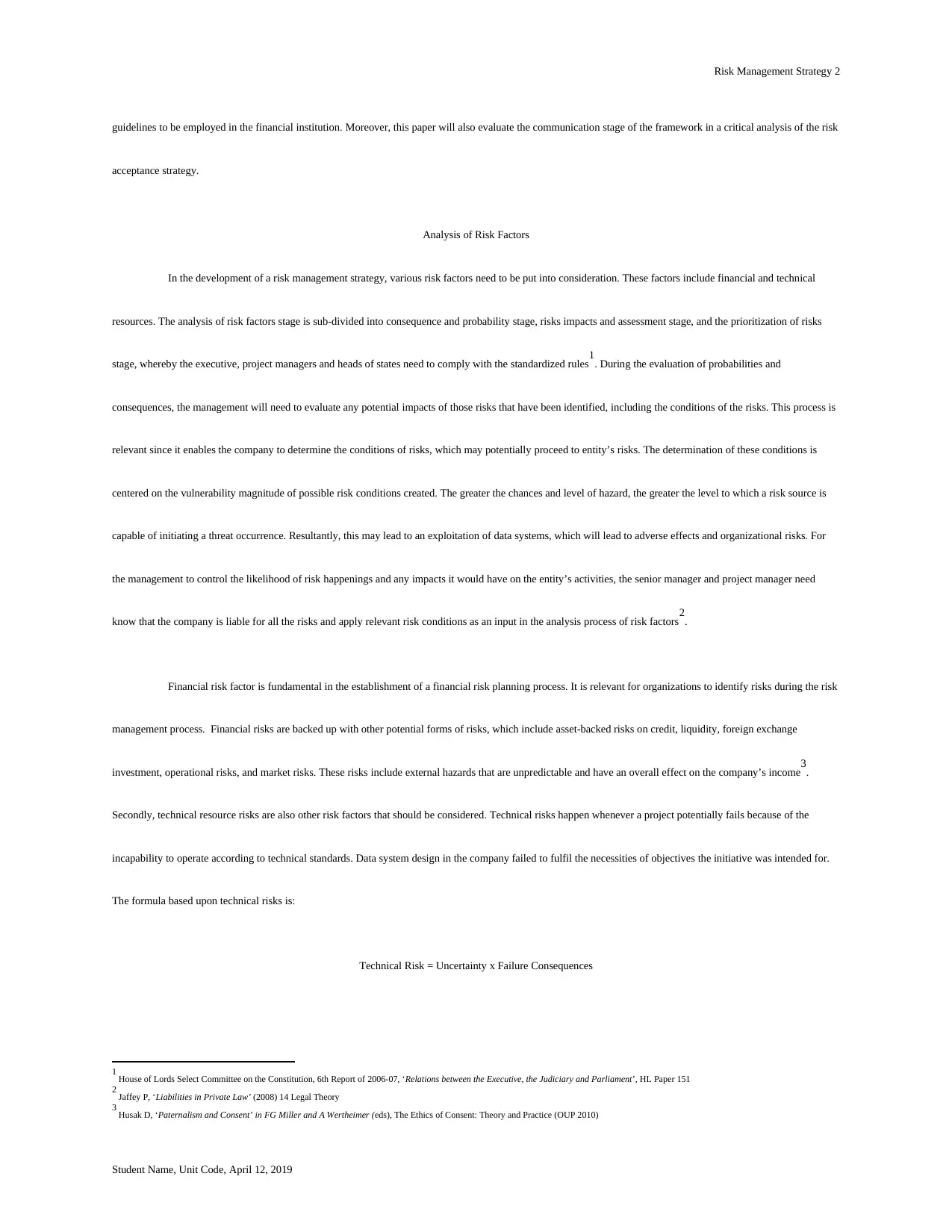
Risk Management Strategy 2
guidelines to be employed in the financial institution. Moreover, this paper will also evaluate the communication stage of the framework in a critical analysis of the risk
acceptance strategy.
Analysis of Risk Factors
In the development of a risk management strategy, various risk factors need to be put into consideration. These factors include financial and technical
resources. The analysis of risk factors stage is sub-divided into consequence and probability stage, risks impacts and assessment stage, and the prioritization of risks
stage, whereby the executive, project managers and heads of states need to comply with the standardized rules1. During the evaluation of probabilities and
consequences, the management will need to evaluate any potential impacts of those risks that have been identified, including the conditions of the risks. This process is
relevant since it enables the company to determine the conditions of risks, which may potentially proceed to entity’s risks. The determination of these conditions is
centered on the vulnerability magnitude of possible risk conditions created. The greater the chances and level of hazard, the greater the level to which a risk source is
capable of initiating a threat occurrence. Resultantly, this may lead to an exploitation of data systems, which will lead to adverse effects and organizational risks. For
the management to control the likelihood of risk happenings and any impacts it would have on the entity’s activities, the senior manager and project manager need
know that the company is liable for all the risks and apply relevant risk conditions as an input in the analysis process of risk factors2.
Financial risk factor is fundamental in the establishment of a financial risk planning process. It is relevant for organizations to identify risks during the risk
management process. Financial risks are backed up with other potential forms of risks, which include asset-backed risks on credit, liquidity, foreign exchange
investment, operational risks, and market risks. These risks include external hazards that are unpredictable and have an overall effect on the company’s income3.
Secondly, technical resource risks are also other risk factors that should be considered. Technical risks happen whenever a project potentially fails because of the
incapability to operate according to technical standards. Data system design in the company failed to fulfil the necessities of objectives the initiative was intended for.
The formula based upon technical risks is:
Technical Risk = Uncertainty x Failure Consequences
1 House of Lords Select Committee on the Constitution, 6th Report of 2006-07, ‘Relations between the Executive, the Judiciary and Parliament’, HL Paper 151
2 Jaffey P, ‘Liabilities in Private Law’ (2008) 14 Legal Theory
3 Husak D, ‘Paternalism and Consent’ in FG Miller and A Wertheimer (eds), The Ethics of Consent: Theory and Practice (OUP 2010)
Student Name, Unit Code, April 12, 2019
guidelines to be employed in the financial institution. Moreover, this paper will also evaluate the communication stage of the framework in a critical analysis of the risk
acceptance strategy.
Analysis of Risk Factors
In the development of a risk management strategy, various risk factors need to be put into consideration. These factors include financial and technical
resources. The analysis of risk factors stage is sub-divided into consequence and probability stage, risks impacts and assessment stage, and the prioritization of risks
stage, whereby the executive, project managers and heads of states need to comply with the standardized rules1. During the evaluation of probabilities and
consequences, the management will need to evaluate any potential impacts of those risks that have been identified, including the conditions of the risks. This process is
relevant since it enables the company to determine the conditions of risks, which may potentially proceed to entity’s risks. The determination of these conditions is
centered on the vulnerability magnitude of possible risk conditions created. The greater the chances and level of hazard, the greater the level to which a risk source is
capable of initiating a threat occurrence. Resultantly, this may lead to an exploitation of data systems, which will lead to adverse effects and organizational risks. For
the management to control the likelihood of risk happenings and any impacts it would have on the entity’s activities, the senior manager and project manager need
know that the company is liable for all the risks and apply relevant risk conditions as an input in the analysis process of risk factors2.
Financial risk factor is fundamental in the establishment of a financial risk planning process. It is relevant for organizations to identify risks during the risk
management process. Financial risks are backed up with other potential forms of risks, which include asset-backed risks on credit, liquidity, foreign exchange
investment, operational risks, and market risks. These risks include external hazards that are unpredictable and have an overall effect on the company’s income3.
Secondly, technical resource risks are also other risk factors that should be considered. Technical risks happen whenever a project potentially fails because of the
incapability to operate according to technical standards. Data system design in the company failed to fulfil the necessities of objectives the initiative was intended for.
The formula based upon technical risks is:
Technical Risk = Uncertainty x Failure Consequences
1 House of Lords Select Committee on the Constitution, 6th Report of 2006-07, ‘Relations between the Executive, the Judiciary and Parliament’, HL Paper 151
2 Jaffey P, ‘Liabilities in Private Law’ (2008) 14 Legal Theory
3 Husak D, ‘Paternalism and Consent’ in FG Miller and A Wertheimer (eds), The Ethics of Consent: Theory and Practice (OUP 2010)
Student Name, Unit Code, April 12, 2019
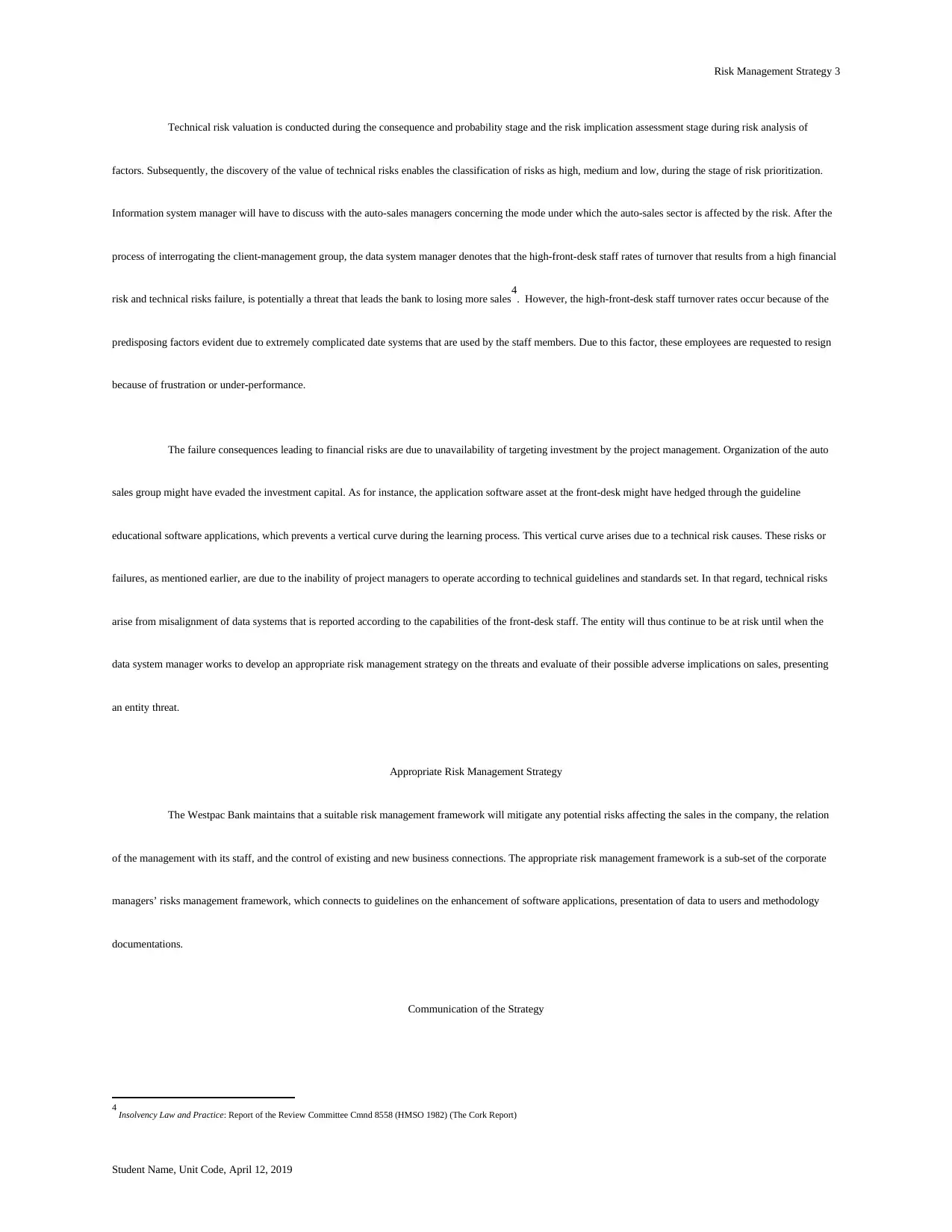
Risk Management Strategy 3
Technical risk valuation is conducted during the consequence and probability stage and the risk implication assessment stage during risk analysis of
factors. Subsequently, the discovery of the value of technical risks enables the classification of risks as high, medium and low, during the stage of risk prioritization.
Information system manager will have to discuss with the auto-sales managers concerning the mode under which the auto-sales sector is affected by the risk. After the
process of interrogating the client-management group, the data system manager denotes that the high-front-desk staff rates of turnover that results from a high financial
risk and technical risks failure, is potentially a threat that leads the bank to losing more sales4. However, the high-front-desk staff turnover rates occur because of the
predisposing factors evident due to extremely complicated date systems that are used by the staff members. Due to this factor, these employees are requested to resign
because of frustration or under-performance.
The failure consequences leading to financial risks are due to unavailability of targeting investment by the project management. Organization of the auto
sales group might have evaded the investment capital. As for instance, the application software asset at the front-desk might have hedged through the guideline
educational software applications, which prevents a vertical curve during the learning process. This vertical curve arises due to a technical risk causes. These risks or
failures, as mentioned earlier, are due to the inability of project managers to operate according to technical guidelines and standards set. In that regard, technical risks
arise from misalignment of data systems that is reported according to the capabilities of the front-desk staff. The entity will thus continue to be at risk until when the
data system manager works to develop an appropriate risk management strategy on the threats and evaluate of their possible adverse implications on sales, presenting
an entity threat.
Appropriate Risk Management Strategy
The Westpac Bank maintains that a suitable risk management framework will mitigate any potential risks affecting the sales in the company, the relation
of the management with its staff, and the control of existing and new business connections. The appropriate risk management framework is a sub-set of the corporate
managers’ risks management framework, which connects to guidelines on the enhancement of software applications, presentation of data to users and methodology
documentations.
Communication of the Strategy
4 Insolvency Law and Practice: Report of the Review Committee Cmnd 8558 (HMSO 1982) (The Cork Report)
Student Name, Unit Code, April 12, 2019
Technical risk valuation is conducted during the consequence and probability stage and the risk implication assessment stage during risk analysis of
factors. Subsequently, the discovery of the value of technical risks enables the classification of risks as high, medium and low, during the stage of risk prioritization.
Information system manager will have to discuss with the auto-sales managers concerning the mode under which the auto-sales sector is affected by the risk. After the
process of interrogating the client-management group, the data system manager denotes that the high-front-desk staff rates of turnover that results from a high financial
risk and technical risks failure, is potentially a threat that leads the bank to losing more sales4. However, the high-front-desk staff turnover rates occur because of the
predisposing factors evident due to extremely complicated date systems that are used by the staff members. Due to this factor, these employees are requested to resign
because of frustration or under-performance.
The failure consequences leading to financial risks are due to unavailability of targeting investment by the project management. Organization of the auto
sales group might have evaded the investment capital. As for instance, the application software asset at the front-desk might have hedged through the guideline
educational software applications, which prevents a vertical curve during the learning process. This vertical curve arises due to a technical risk causes. These risks or
failures, as mentioned earlier, are due to the inability of project managers to operate according to technical guidelines and standards set. In that regard, technical risks
arise from misalignment of data systems that is reported according to the capabilities of the front-desk staff. The entity will thus continue to be at risk until when the
data system manager works to develop an appropriate risk management strategy on the threats and evaluate of their possible adverse implications on sales, presenting
an entity threat.
Appropriate Risk Management Strategy
The Westpac Bank maintains that a suitable risk management framework will mitigate any potential risks affecting the sales in the company, the relation
of the management with its staff, and the control of existing and new business connections. The appropriate risk management framework is a sub-set of the corporate
managers’ risks management framework, which connects to guidelines on the enhancement of software applications, presentation of data to users and methodology
documentations.
Communication of the Strategy
4 Insolvency Law and Practice: Report of the Review Committee Cmnd 8558 (HMSO 1982) (The Cork Report)
Student Name, Unit Code, April 12, 2019
⊘ This is a preview!⊘
Do you want full access?
Subscribe today to unlock all pages.

Trusted by 1+ million students worldwide
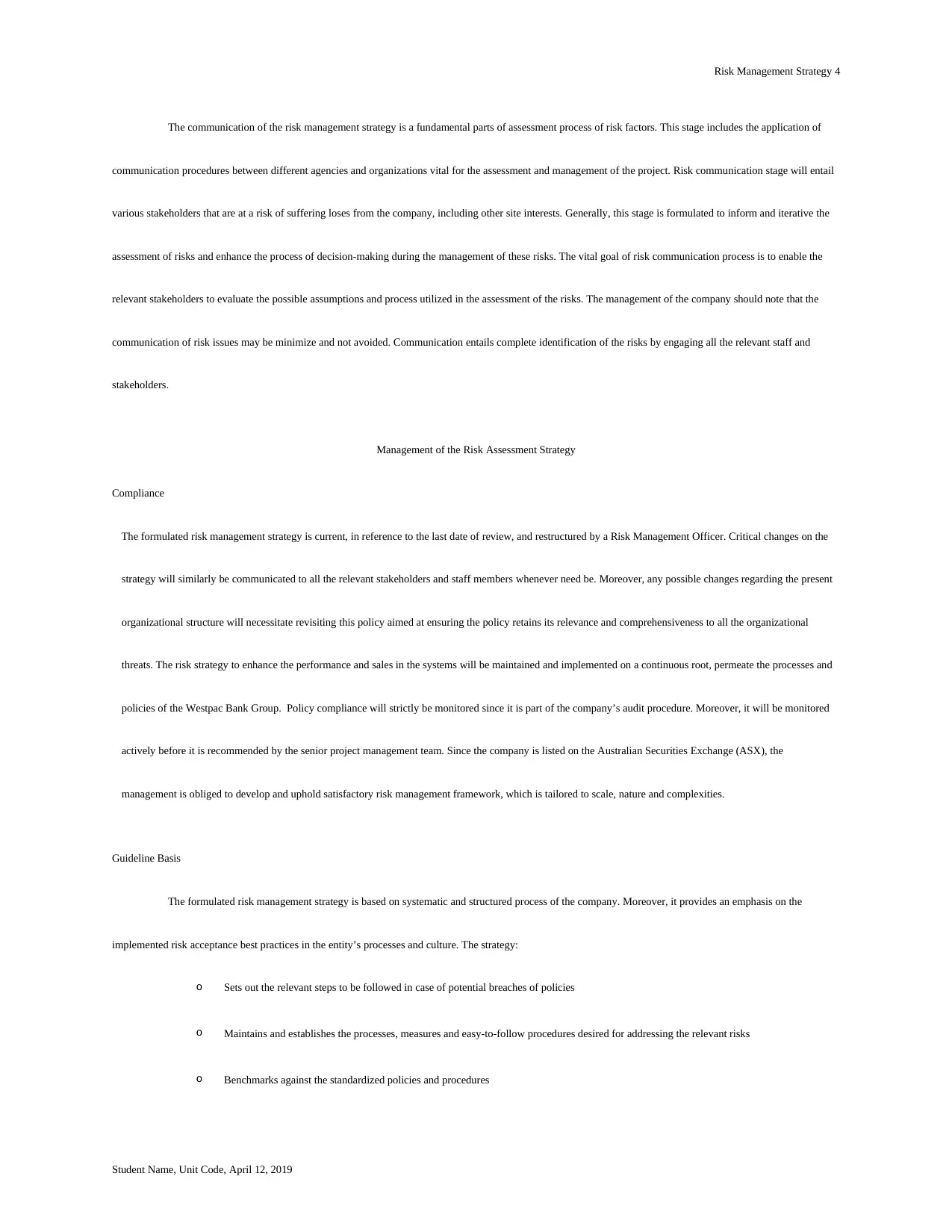
Risk Management Strategy 4
The communication of the risk management strategy is a fundamental parts of assessment process of risk factors. This stage includes the application of
communication procedures between different agencies and organizations vital for the assessment and management of the project. Risk communication stage will entail
various stakeholders that are at a risk of suffering loses from the company, including other site interests. Generally, this stage is formulated to inform and iterative the
assessment of risks and enhance the process of decision-making during the management of these risks. The vital goal of risk communication process is to enable the
relevant stakeholders to evaluate the possible assumptions and process utilized in the assessment of the risks. The management of the company should note that the
communication of risk issues may be minimize and not avoided. Communication entails complete identification of the risks by engaging all the relevant staff and
stakeholders.
Management of the Risk Assessment Strategy
Compliance
The formulated risk management strategy is current, in reference to the last date of review, and restructured by a Risk Management Officer. Critical changes on the
strategy will similarly be communicated to all the relevant stakeholders and staff members whenever need be. Moreover, any possible changes regarding the present
organizational structure will necessitate revisiting this policy aimed at ensuring the policy retains its relevance and comprehensiveness to all the organizational
threats. The risk strategy to enhance the performance and sales in the systems will be maintained and implemented on a continuous root, permeate the processes and
policies of the Westpac Bank Group. Policy compliance will strictly be monitored since it is part of the company’s audit procedure. Moreover, it will be monitored
actively before it is recommended by the senior project management team. Since the company is listed on the Australian Securities Exchange (ASX), the
management is obliged to develop and uphold satisfactory risk management framework, which is tailored to scale, nature and complexities.
Guideline Basis
The formulated risk management strategy is based on systematic and structured process of the company. Moreover, it provides an emphasis on the
implemented risk acceptance best practices in the entity’s processes and culture. The strategy:
o Sets out the relevant steps to be followed in case of potential breaches of policies
o Maintains and establishes the processes, measures and easy-to-follow procedures desired for addressing the relevant risks
o Benchmarks against the standardized policies and procedures
Student Name, Unit Code, April 12, 2019
The communication of the risk management strategy is a fundamental parts of assessment process of risk factors. This stage includes the application of
communication procedures between different agencies and organizations vital for the assessment and management of the project. Risk communication stage will entail
various stakeholders that are at a risk of suffering loses from the company, including other site interests. Generally, this stage is formulated to inform and iterative the
assessment of risks and enhance the process of decision-making during the management of these risks. The vital goal of risk communication process is to enable the
relevant stakeholders to evaluate the possible assumptions and process utilized in the assessment of the risks. The management of the company should note that the
communication of risk issues may be minimize and not avoided. Communication entails complete identification of the risks by engaging all the relevant staff and
stakeholders.
Management of the Risk Assessment Strategy
Compliance
The formulated risk management strategy is current, in reference to the last date of review, and restructured by a Risk Management Officer. Critical changes on the
strategy will similarly be communicated to all the relevant stakeholders and staff members whenever need be. Moreover, any possible changes regarding the present
organizational structure will necessitate revisiting this policy aimed at ensuring the policy retains its relevance and comprehensiveness to all the organizational
threats. The risk strategy to enhance the performance and sales in the systems will be maintained and implemented on a continuous root, permeate the processes and
policies of the Westpac Bank Group. Policy compliance will strictly be monitored since it is part of the company’s audit procedure. Moreover, it will be monitored
actively before it is recommended by the senior project management team. Since the company is listed on the Australian Securities Exchange (ASX), the
management is obliged to develop and uphold satisfactory risk management framework, which is tailored to scale, nature and complexities.
Guideline Basis
The formulated risk management strategy is based on systematic and structured process of the company. Moreover, it provides an emphasis on the
implemented risk acceptance best practices in the entity’s processes and culture. The strategy:
o Sets out the relevant steps to be followed in case of potential breaches of policies
o Maintains and establishes the processes, measures and easy-to-follow procedures desired for addressing the relevant risks
o Benchmarks against the standardized policies and procedures
Student Name, Unit Code, April 12, 2019
Paraphrase This Document
Need a fresh take? Get an instant paraphrase of this document with our AI Paraphraser
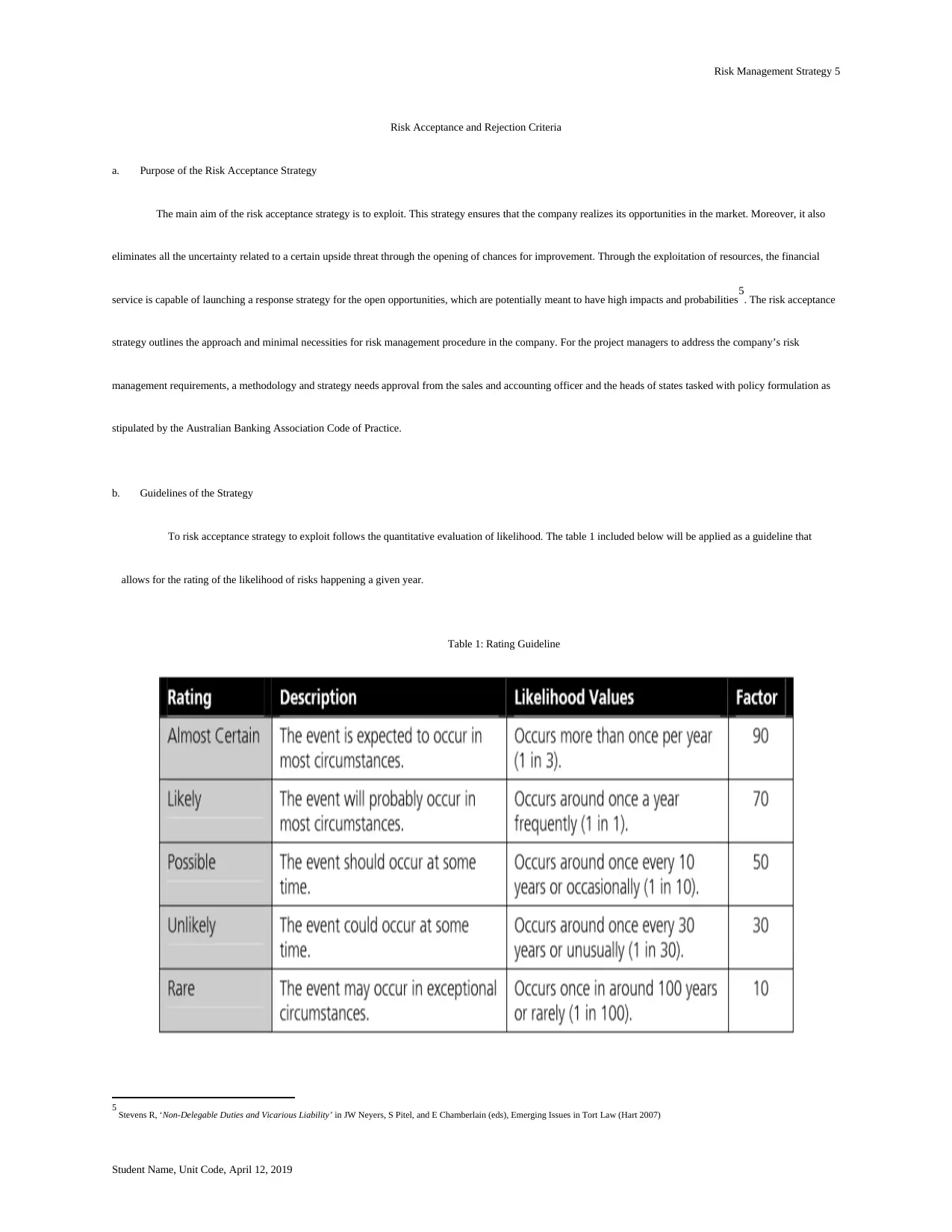
Risk Management Strategy 5
Risk Acceptance and Rejection Criteria
a. Purpose of the Risk Acceptance Strategy
The main aim of the risk acceptance strategy is to exploit. This strategy ensures that the company realizes its opportunities in the market. Moreover, it also
eliminates all the uncertainty related to a certain upside threat through the opening of chances for improvement. Through the exploitation of resources, the financial
service is capable of launching a response strategy for the open opportunities, which are potentially meant to have high impacts and probabilities5. The risk acceptance
strategy outlines the approach and minimal necessities for risk management procedure in the company. For the project managers to address the company’s risk
management requirements, a methodology and strategy needs approval from the sales and accounting officer and the heads of states tasked with policy formulation as
stipulated by the Australian Banking Association Code of Practice.
b. Guidelines of the Strategy
To risk acceptance strategy to exploit follows the quantitative evaluation of likelihood. The table 1 included below will be applied as a guideline that
allows for the rating of the likelihood of risks happening a given year.
Table 1: Rating Guideline
5 Stevens R, ‘Non-Delegable Duties and Vicarious Liability’ in JW Neyers, S Pitel, and E Chamberlain (eds), Emerging Issues in Tort Law (Hart 2007)
Student Name, Unit Code, April 12, 2019
Risk Acceptance and Rejection Criteria
a. Purpose of the Risk Acceptance Strategy
The main aim of the risk acceptance strategy is to exploit. This strategy ensures that the company realizes its opportunities in the market. Moreover, it also
eliminates all the uncertainty related to a certain upside threat through the opening of chances for improvement. Through the exploitation of resources, the financial
service is capable of launching a response strategy for the open opportunities, which are potentially meant to have high impacts and probabilities5. The risk acceptance
strategy outlines the approach and minimal necessities for risk management procedure in the company. For the project managers to address the company’s risk
management requirements, a methodology and strategy needs approval from the sales and accounting officer and the heads of states tasked with policy formulation as
stipulated by the Australian Banking Association Code of Practice.
b. Guidelines of the Strategy
To risk acceptance strategy to exploit follows the quantitative evaluation of likelihood. The table 1 included below will be applied as a guideline that
allows for the rating of the likelihood of risks happening a given year.
Table 1: Rating Guideline
5 Stevens R, ‘Non-Delegable Duties and Vicarious Liability’ in JW Neyers, S Pitel, and E Chamberlain (eds), Emerging Issues in Tort Law (Hart 2007)
Student Name, Unit Code, April 12, 2019
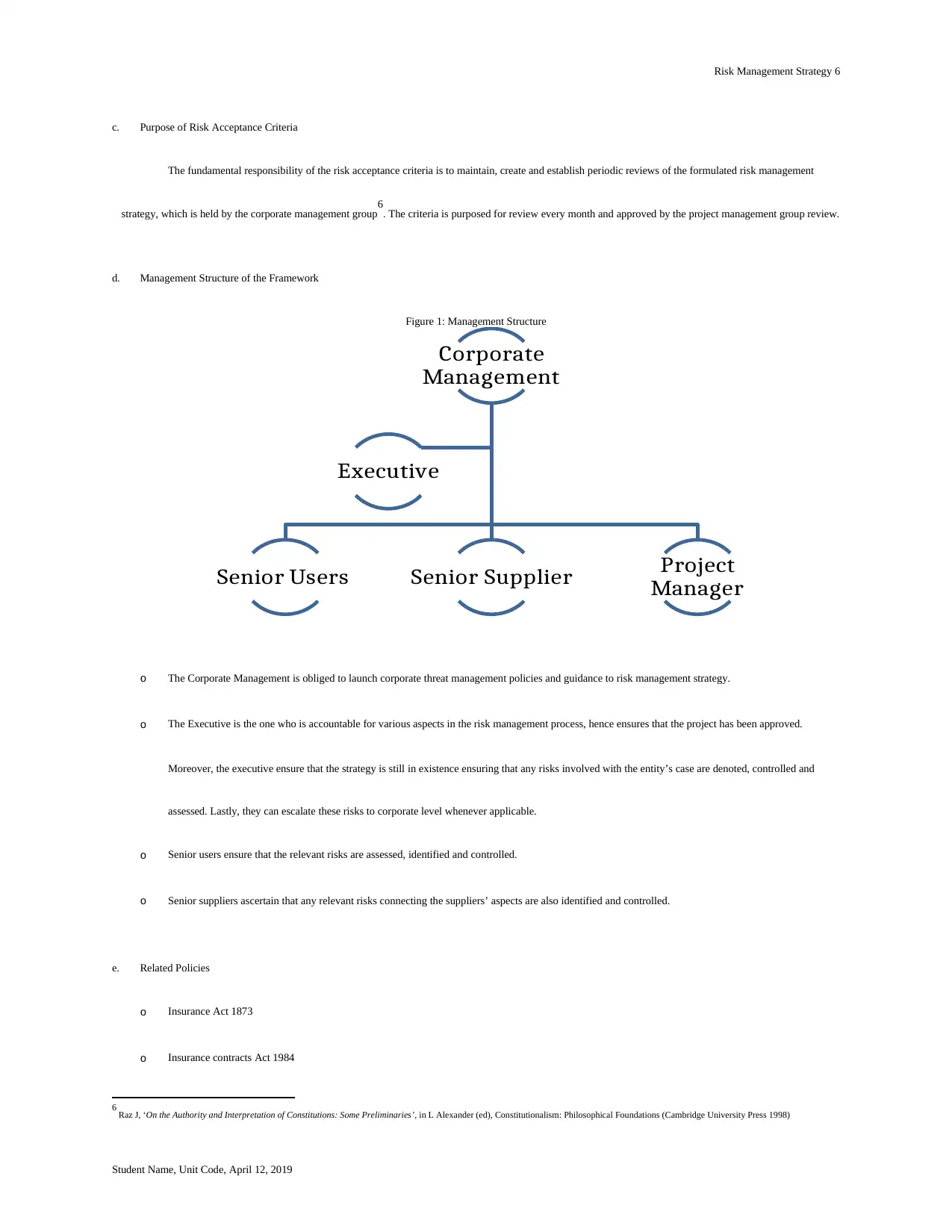
Risk Management Strategy 6
c. Purpose of Risk Acceptance Criteria
The fundamental responsibility of the risk acceptance criteria is to maintain, create and establish periodic reviews of the formulated risk management
strategy, which is held by the corporate management group6. The criteria is purposed for review every month and approved by the project management group review.
d. Management Structure of the Framework
Figure 1: Management Structure
o The Corporate Management is obliged to launch corporate threat management policies and guidance to risk management strategy.
o The Executive is the one who is accountable for various aspects in the risk management process, hence ensures that the project has been approved.
Moreover, the executive ensure that the strategy is still in existence ensuring that any risks involved with the entity’s case are denoted, controlled and
assessed. Lastly, they can escalate these risks to corporate level whenever applicable.
o Senior users ensure that the relevant risks are assessed, identified and controlled.
o Senior suppliers ascertain that any relevant risks connecting the suppliers’ aspects are also identified and controlled.
e. Related Policies
o Insurance Act 1873
o Insurance contracts Act 1984
6 Raz J, ‘On the Authority and Interpretation of Constitutions: Some Preliminaries’, in L Alexander (ed), Constitutionalism: Philosophical Foundations (Cambridge University Press 1998)
Student Name, Unit Code, April 12, 2019
Corporate
Management
Senior Users Senior Supplier Project
Manager
Executive
c. Purpose of Risk Acceptance Criteria
The fundamental responsibility of the risk acceptance criteria is to maintain, create and establish periodic reviews of the formulated risk management
strategy, which is held by the corporate management group6. The criteria is purposed for review every month and approved by the project management group review.
d. Management Structure of the Framework
Figure 1: Management Structure
o The Corporate Management is obliged to launch corporate threat management policies and guidance to risk management strategy.
o The Executive is the one who is accountable for various aspects in the risk management process, hence ensures that the project has been approved.
Moreover, the executive ensure that the strategy is still in existence ensuring that any risks involved with the entity’s case are denoted, controlled and
assessed. Lastly, they can escalate these risks to corporate level whenever applicable.
o Senior users ensure that the relevant risks are assessed, identified and controlled.
o Senior suppliers ascertain that any relevant risks connecting the suppliers’ aspects are also identified and controlled.
e. Related Policies
o Insurance Act 1873
o Insurance contracts Act 1984
6 Raz J, ‘On the Authority and Interpretation of Constitutions: Some Preliminaries’, in L Alexander (ed), Constitutionalism: Philosophical Foundations (Cambridge University Press 1998)
Student Name, Unit Code, April 12, 2019
Corporate
Management
Senior Users Senior Supplier Project
Manager
Executive
⊘ This is a preview!⊘
Do you want full access?
Subscribe today to unlock all pages.

Trusted by 1+ million students worldwide
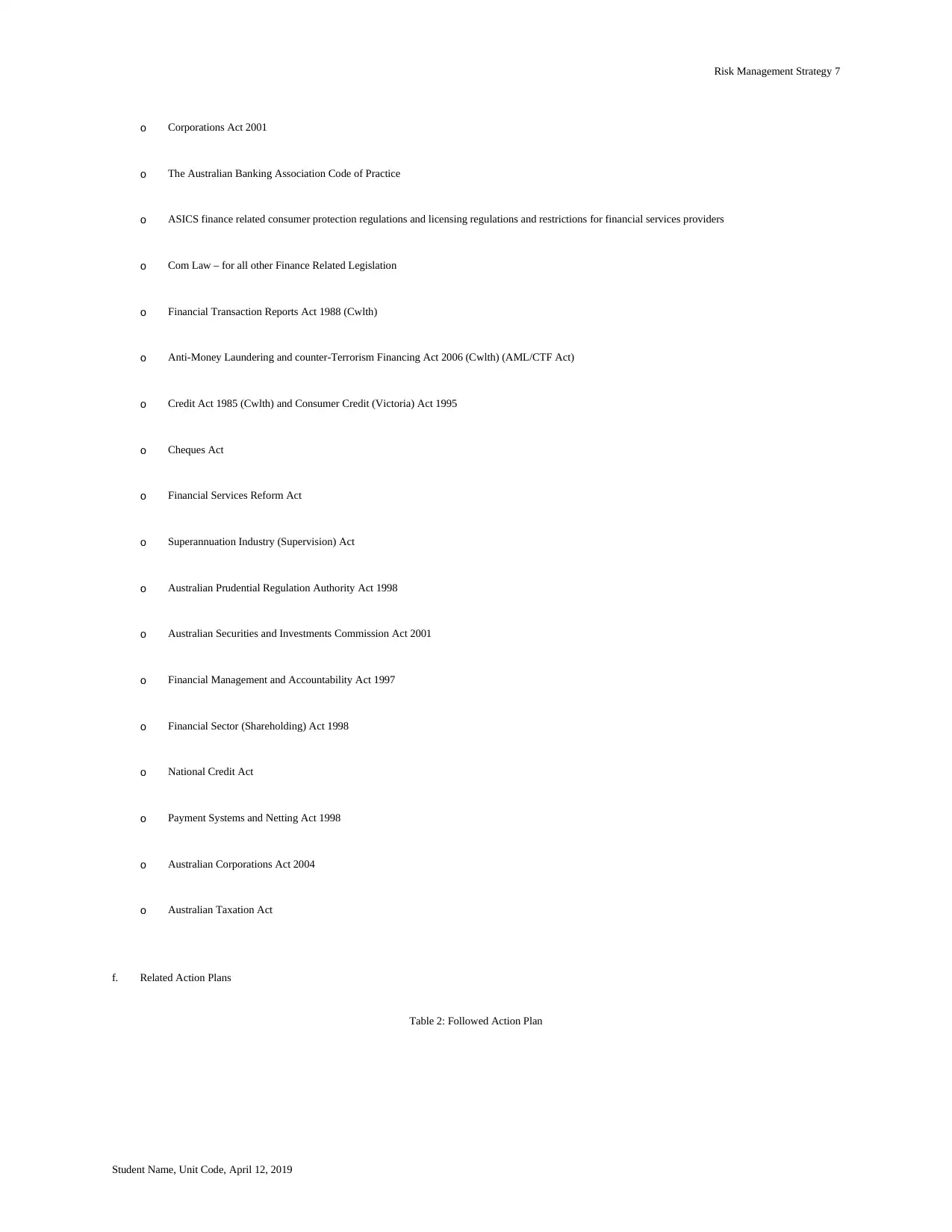
Risk Management Strategy 7
o Corporations Act 2001
o The Australian Banking Association Code of Practice
o ASICS finance related consumer protection regulations and licensing regulations and restrictions for financial services providers
o Com Law – for all other Finance Related Legislation
o Financial Transaction Reports Act 1988 (Cwlth)
o Anti-Money Laundering and counter-Terrorism Financing Act 2006 (Cwlth) (AML/CTF Act)
o Credit Act 1985 (Cwlth) and Consumer Credit (Victoria) Act 1995
o Cheques Act
o Financial Services Reform Act
o Superannuation Industry (Supervision) Act
o Australian Prudential Regulation Authority Act 1998
o Australian Securities and Investments Commission Act 2001
o Financial Management and Accountability Act 1997
o Financial Sector (Shareholding) Act 1998
o National Credit Act
o Payment Systems and Netting Act 1998
o Australian Corporations Act 2004
o Australian Taxation Act
f. Related Action Plans
Table 2: Followed Action Plan
Student Name, Unit Code, April 12, 2019
o Corporations Act 2001
o The Australian Banking Association Code of Practice
o ASICS finance related consumer protection regulations and licensing regulations and restrictions for financial services providers
o Com Law – for all other Finance Related Legislation
o Financial Transaction Reports Act 1988 (Cwlth)
o Anti-Money Laundering and counter-Terrorism Financing Act 2006 (Cwlth) (AML/CTF Act)
o Credit Act 1985 (Cwlth) and Consumer Credit (Victoria) Act 1995
o Cheques Act
o Financial Services Reform Act
o Superannuation Industry (Supervision) Act
o Australian Prudential Regulation Authority Act 1998
o Australian Securities and Investments Commission Act 2001
o Financial Management and Accountability Act 1997
o Financial Sector (Shareholding) Act 1998
o National Credit Act
o Payment Systems and Netting Act 1998
o Australian Corporations Act 2004
o Australian Taxation Act
f. Related Action Plans
Table 2: Followed Action Plan
Student Name, Unit Code, April 12, 2019
Paraphrase This Document
Need a fresh take? Get an instant paraphrase of this document with our AI Paraphraser
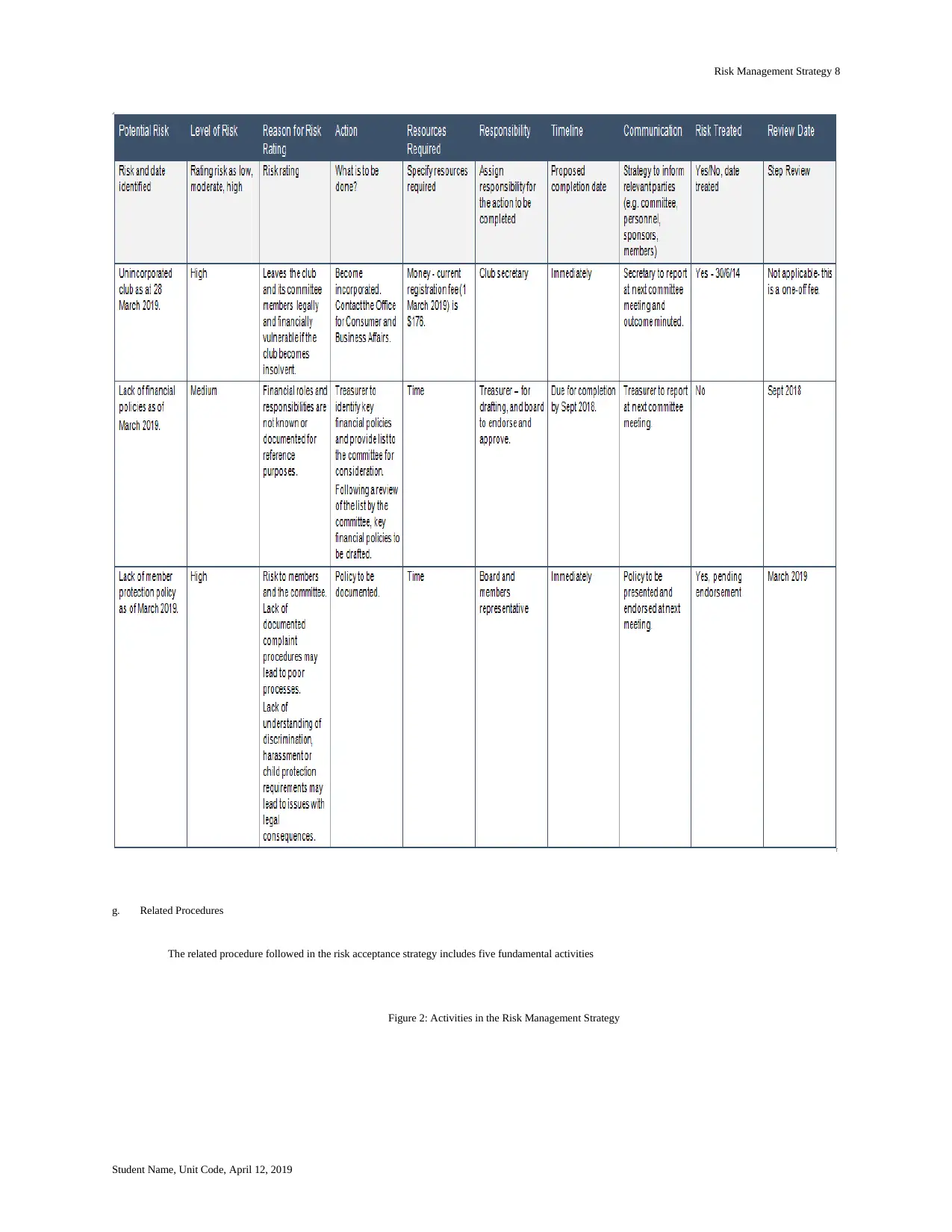
Risk Management Strategy 8
g. Related Procedures
The related procedure followed in the risk acceptance strategy includes five fundamental activities
Figure 2: Activities in the Risk Management Strategy
Student Name, Unit Code, April 12, 2019
g. Related Procedures
The related procedure followed in the risk acceptance strategy includes five fundamental activities
Figure 2: Activities in the Risk Management Strategy
Student Name, Unit Code, April 12, 2019
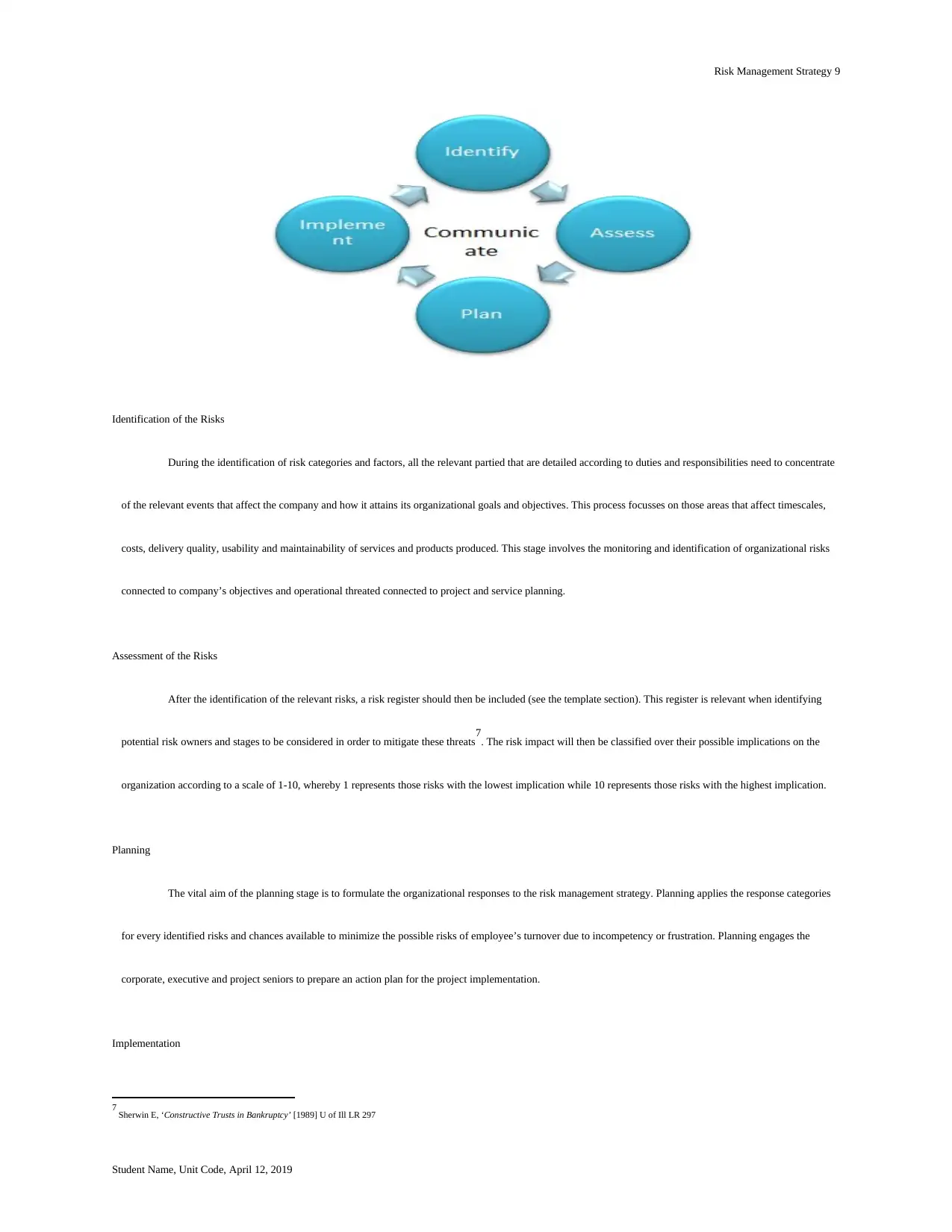
Risk Management Strategy 9
Identification of the Risks
During the identification of risk categories and factors, all the relevant partied that are detailed according to duties and responsibilities need to concentrate
of the relevant events that affect the company and how it attains its organizational goals and objectives. This process focusses on those areas that affect timescales,
costs, delivery quality, usability and maintainability of services and products produced. This stage involves the monitoring and identification of organizational risks
connected to company’s objectives and operational threated connected to project and service planning.
Assessment of the Risks
After the identification of the relevant risks, a risk register should then be included (see the template section). This register is relevant when identifying
potential risk owners and stages to be considered in order to mitigate these threats7. The risk impact will then be classified over their possible implications on the
organization according to a scale of 1-10, whereby 1 represents those risks with the lowest implication while 10 represents those risks with the highest implication.
Planning
The vital aim of the planning stage is to formulate the organizational responses to the risk management strategy. Planning applies the response categories
for every identified risks and chances available to minimize the possible risks of employee’s turnover due to incompetency or frustration. Planning engages the
corporate, executive and project seniors to prepare an action plan for the project implementation.
Implementation
7 Sherwin E, ‘Constructive Trusts in Bankruptcy’ [1989] U of Ill LR 297
Student Name, Unit Code, April 12, 2019
Identification of the Risks
During the identification of risk categories and factors, all the relevant partied that are detailed according to duties and responsibilities need to concentrate
of the relevant events that affect the company and how it attains its organizational goals and objectives. This process focusses on those areas that affect timescales,
costs, delivery quality, usability and maintainability of services and products produced. This stage involves the monitoring and identification of organizational risks
connected to company’s objectives and operational threated connected to project and service planning.
Assessment of the Risks
After the identification of the relevant risks, a risk register should then be included (see the template section). This register is relevant when identifying
potential risk owners and stages to be considered in order to mitigate these threats7. The risk impact will then be classified over their possible implications on the
organization according to a scale of 1-10, whereby 1 represents those risks with the lowest implication while 10 represents those risks with the highest implication.
Planning
The vital aim of the planning stage is to formulate the organizational responses to the risk management strategy. Planning applies the response categories
for every identified risks and chances available to minimize the possible risks of employee’s turnover due to incompetency or frustration. Planning engages the
corporate, executive and project seniors to prepare an action plan for the project implementation.
Implementation
7 Sherwin E, ‘Constructive Trusts in Bankruptcy’ [1989] U of Ill LR 297
Student Name, Unit Code, April 12, 2019
⊘ This is a preview!⊘
Do you want full access?
Subscribe today to unlock all pages.

Trusted by 1+ million students worldwide
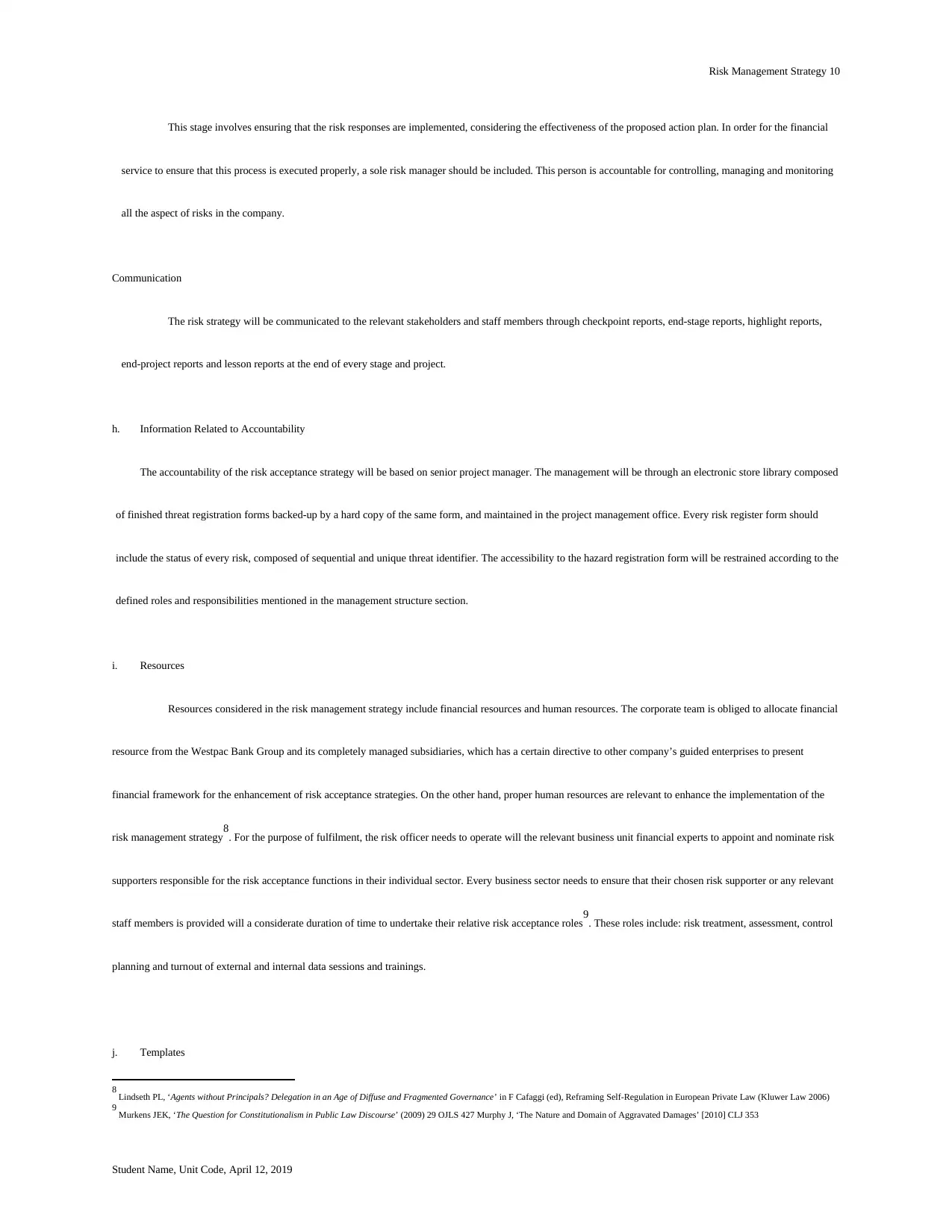
Risk Management Strategy 10
This stage involves ensuring that the risk responses are implemented, considering the effectiveness of the proposed action plan. In order for the financial
service to ensure that this process is executed properly, a sole risk manager should be included. This person is accountable for controlling, managing and monitoring
all the aspect of risks in the company.
Communication
The risk strategy will be communicated to the relevant stakeholders and staff members through checkpoint reports, end-stage reports, highlight reports,
end-project reports and lesson reports at the end of every stage and project.
h. Information Related to Accountability
The accountability of the risk acceptance strategy will be based on senior project manager. The management will be through an electronic store library composed
of finished threat registration forms backed-up by a hard copy of the same form, and maintained in the project management office. Every risk register form should
include the status of every risk, composed of sequential and unique threat identifier. The accessibility to the hazard registration form will be restrained according to the
defined roles and responsibilities mentioned in the management structure section.
i. Resources
Resources considered in the risk management strategy include financial resources and human resources. The corporate team is obliged to allocate financial
resource from the Westpac Bank Group and its completely managed subsidiaries, which has a certain directive to other company’s guided enterprises to present
financial framework for the enhancement of risk acceptance strategies. On the other hand, proper human resources are relevant to enhance the implementation of the
risk management strategy8. For the purpose of fulfilment, the risk officer needs to operate will the relevant business unit financial experts to appoint and nominate risk
supporters responsible for the risk acceptance functions in their individual sector. Every business sector needs to ensure that their chosen risk supporter or any relevant
staff members is provided will a considerate duration of time to undertake their relative risk acceptance roles9. These roles include: risk treatment, assessment, control
planning and turnout of external and internal data sessions and trainings.
j. Templates
8 Lindseth PL, ‘Agents without Principals? Delegation in an Age of Diffuse and Fragmented Governance’ in F Cafaggi (ed), Reframing Self-Regulation in European Private Law (Kluwer Law 2006)
9 Murkens JEK, ‘The Question for Constitutionalism in Public Law Discourse’ (2009) 29 OJLS 427 Murphy J, ‘The Nature and Domain of Aggravated Damages’ [2010] CLJ 353
Student Name, Unit Code, April 12, 2019
This stage involves ensuring that the risk responses are implemented, considering the effectiveness of the proposed action plan. In order for the financial
service to ensure that this process is executed properly, a sole risk manager should be included. This person is accountable for controlling, managing and monitoring
all the aspect of risks in the company.
Communication
The risk strategy will be communicated to the relevant stakeholders and staff members through checkpoint reports, end-stage reports, highlight reports,
end-project reports and lesson reports at the end of every stage and project.
h. Information Related to Accountability
The accountability of the risk acceptance strategy will be based on senior project manager. The management will be through an electronic store library composed
of finished threat registration forms backed-up by a hard copy of the same form, and maintained in the project management office. Every risk register form should
include the status of every risk, composed of sequential and unique threat identifier. The accessibility to the hazard registration form will be restrained according to the
defined roles and responsibilities mentioned in the management structure section.
i. Resources
Resources considered in the risk management strategy include financial resources and human resources. The corporate team is obliged to allocate financial
resource from the Westpac Bank Group and its completely managed subsidiaries, which has a certain directive to other company’s guided enterprises to present
financial framework for the enhancement of risk acceptance strategies. On the other hand, proper human resources are relevant to enhance the implementation of the
risk management strategy8. For the purpose of fulfilment, the risk officer needs to operate will the relevant business unit financial experts to appoint and nominate risk
supporters responsible for the risk acceptance functions in their individual sector. Every business sector needs to ensure that their chosen risk supporter or any relevant
staff members is provided will a considerate duration of time to undertake their relative risk acceptance roles9. These roles include: risk treatment, assessment, control
planning and turnout of external and internal data sessions and trainings.
j. Templates
8 Lindseth PL, ‘Agents without Principals? Delegation in an Age of Diffuse and Fragmented Governance’ in F Cafaggi (ed), Reframing Self-Regulation in European Private Law (Kluwer Law 2006)
9 Murkens JEK, ‘The Question for Constitutionalism in Public Law Discourse’ (2009) 29 OJLS 427 Murphy J, ‘The Nature and Domain of Aggravated Damages’ [2010] CLJ 353
Student Name, Unit Code, April 12, 2019
Paraphrase This Document
Need a fresh take? Get an instant paraphrase of this document with our AI Paraphraser

Risk Management Strategy 11
Figure 3: Risk Resources Checklist
Figure 4: Risk Register
Student Name, Unit Code, April 12, 2019
Figure 3: Risk Resources Checklist
Figure 4: Risk Register
Student Name, Unit Code, April 12, 2019

Risk Management Strategy 12
k. Reporting Structure
Separate overviews of the relevant risks will be documented in the summary of risks that will be accessible for any authorized persons, circulated around
the project management board. The risk reporting structure summary is as follows:
Figure 5: Risk Reporting Structure
l. Recording Structure
Figure 6: Risk Recording Structure
Student Name, Unit Code, April 12, 2019
Introduction
Programe Name
Risk Identifier
Body
Summary of the Risk
Risk Categorization
Conclusion
Current Risk Evaluation
Present Risk Evaluation
Date
k. Reporting Structure
Separate overviews of the relevant risks will be documented in the summary of risks that will be accessible for any authorized persons, circulated around
the project management board. The risk reporting structure summary is as follows:
Figure 5: Risk Reporting Structure
l. Recording Structure
Figure 6: Risk Recording Structure
Student Name, Unit Code, April 12, 2019
Introduction
Programe Name
Risk Identifier
Body
Summary of the Risk
Risk Categorization
Conclusion
Current Risk Evaluation
Present Risk Evaluation
Date
⊘ This is a preview!⊘
Do you want full access?
Subscribe today to unlock all pages.

Trusted by 1+ million students worldwide
1 out of 16
Related Documents
Your All-in-One AI-Powered Toolkit for Academic Success.
+13062052269
info@desklib.com
Available 24*7 on WhatsApp / Email
![[object Object]](/_next/static/media/star-bottom.7253800d.svg)
Unlock your academic potential
Copyright © 2020–2025 A2Z Services. All Rights Reserved. Developed and managed by ZUCOL.




